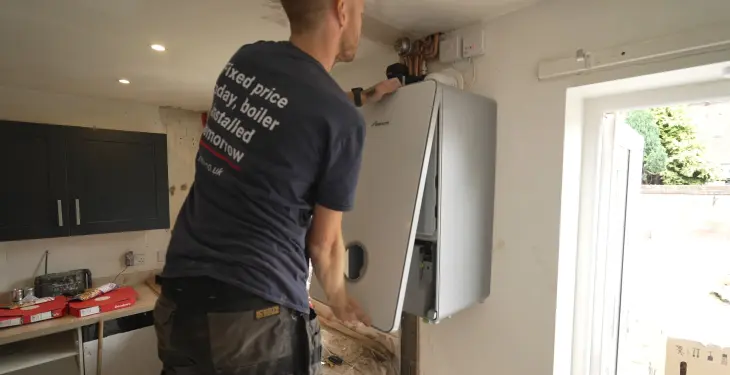

Written by Stephen Day
Gas Safe Engineer
Updated: 9th June, 2025
A Worcester Bosch boiler is a complex machine with many components working together to heat your home efficiently and safely.
Get a new boiler quote, save up to £550 per year (0% APR available).
If your Worcester Bosch boiler's pressure is low and you don't have the key, don't worry. Many homeowners face this issue but the solution is quite straightforward. To increase the pressure, locate the external filling loop on your boiler, then open the valves to allow water to flow into the system. Monitor the pressure gauge closely, ensuring it reaches between 1 to 1.5 bar.
Central heating systems rely on the correct boiler pressure to function efficiently. When the pressure drops, your boiler may not work properly, affecting your home's heating and hot water supply. Learning how to re-pressurise the system without a key will save you from unnecessary service calls and keep your boiler running smoothly.
Before you start, ensure you have a good understanding of your boiler’s components. By following some simple steps, you can safely and effectively boost your boiler’s pressure. Keeping your Worcester boiler at the right pressure ensures optimal performance and a comfortable, warm home.
Get a quote in 60 seconds, fitted as fast as next day!
0% APR finance available.
A Worcester Bosch boiler is a complex machine with many components working together to heat your home efficiently, quickly and safely. It’s crucial to understand the key parts and their functions, safety features, and performance measures.
The main components of a Worcester Bosch boiler include the Pressure Gauge, Valves, and Expansion Vessel. The pressure gauge lets you monitor the water pressure in the system. Ideal pressure levels are between 1-1.5 bar when the system is off.
Valves control the flow of water and gas. They are vital for maintaining the correct pressure levels. The expansion vessel helps manage the water's expansion as it heats. This vessel absorbs excess pressure, preventing the system from damage.
Safety features are a critical part of the Worcester Bosch boiler. The Pressure Relief Valve is essential. It releases excess water if the pressure gets too high, protecting the boiler from potential damage.
Overheating protection shuts the boiler down if it gets too hot. This keeps you safe and prevents damage to the boiler. Anti-frost protection is another important feature, stopping the boiler's components from freezing in cold weather.
Efficiency is a key factor in the performance of Worcester Bosch boilers. These boilers are designed to be highly efficient, converting most of the fuel into heat. This can lead to lower energy bills and reduced carbon emissions.
A Worcester Bosch boiler usually has a high efficiency rating, often reaching up to 90% or above. This high efficiency means the boiler uses less fuel to provide the same amount of heat. Regular maintenance and monitoring can help keep the boiler running efficiently for years.
Identifying low pressure issues in your Worcester Bosch boiler is crucial for maintaining a well-functioning heating system. Key symptoms can signal when your boiler's pressure is too low, and checking the pressure gauge regularly can help you stay on top of any issues.
Low boiler pressure can lead to a variety of issues within your heating system. One of the most noticeable problems is the lack of hot water. If the water from your taps isn't as hot as it should be, or if it takes longer than usual to heat up, this could be a sign of low pressure.
Another common symptom is radiators not heating up properly. If certain rooms in your home feel colder than others, or if you notice cold spots on your radiators, your boiler's pressure may be too low.
You might also hear gurgling or banging noises from your boiler and pipes. This could indicate that air is trapped in the system due to insufficient water pressure.
To confirm whether your boiler's pressure is low, you need to check the pressure gauge. The gauge is usually located on the front of the boiler. It shows the current pressure of the system in bars.
The ideal pressure for most Worcester Bosch boilers is between 1 and 1.5 bars when the system is off. If the pressure reads below 1 bar, it’s definitely too low.
If the pressure gauge needle falls outside the green zone or is near the red mark, it's time to take action. By regularly monitoring the pressure gauge, you can catch pressure issues early and avoid more significant problems with your heating system.
Before re-pressurising a Worcester Bosch Combi Boiler, it is crucial to locate the correct tools and understand the basic system involved. This preparation ensures the process goes smoothly and safely.
The Internal Filling Key is essential for re-pressurising some Worcester Bosch boilers. It is usually stored in a compartment beneath the boiler.
Look for a small, white plastic key. If unfamiliar, refer to the boiler's user manual for specific visual guidance. Once located, ensure it is clean and in good condition. A worn or damaged key might complicate the process or fail to engage properly.
Have a torch handy if lighting is poor in the area around the boiler. This will help in clearly seeing all components and ensuring everything is aligned correctly.
The Filling Loop is the mechanism that allows water to enter the boiler system to increase pressure. There are two main types: the internal filling loop, which uses the filling key, and the external filling loop, found in some models.
An internal filling loop typically involves the key, which must be inserted and turned to open the valve. This allows cold mains water into the system. The pressure gauge should be monitored closely during this process, aiming for a range between 1 and 1.5 bars.
For an external filling loop, two flexible hoses connect to the boiler. Open the valves slowly to allow water to flow in, then close them once the desired pressure is reached. Always check for any leaks during and after the process.
Re-pressurising a Worcester Bosch boiler without a key is possible using either the internal filling mechanism or an external filling loop. Each method involves specific steps to safely increase the pressure.
Locate the filling key: The Worcester Bosch boiler often has a built-in internal key. Find the key within the boiler unit or consult the boiler manual.
Insert the key: Place the key into the keyhole, aligning the arrow with the open padlock symbol.
Turn anti-clockwise: Rotate the key anti-clockwise until it locks into place.
Open the cold water valve: Turn the white square handle clockwise to allow cold water to flow into the system. Listen for the sound of water entering.
Monitor the pressure gauge: Watch the pressure gauge and wait until it reads between 1 and 1.5 bar.
Turn off the valve and key: Once the desired pressure is reached, turn the white handle back and remove the key by turning it clockwise.
Identify external filling loop: External filling loops are usually found below the boiler or near the pipework.
Open the first valve: If there are two valves, start by fully opening one valve.
Slowly open the second valve: Open the second valve gradually until you hear water entering the system.
Monitor the pressure gauge: Keep an eye on the pressure gauge, ensuring the pressure increases to between 1 and 1.5 bar.
Close both valves: Once the appropriate pressure is reached, close each valve carefully to stop the water flow.
Reset the boiler if necessary: Some boilers require a reset after re-pressurising. Check the manual or control panel for reset instructions.
Turn the heating on: Switch on the heating to test if the boiler operates correctly under the correct pressure.
Check for leaks: Inspect the boiler and surrounding pipework for any visible leaks. Address any issues immediately to prevent further problems.
By following these detailed steps, you can safely and efficiently increase the pressure in your Worcester Bosch boiler without using a key.
Once you have successfully increased the pressure on your Worcester Bosch boiler without a key, it's important to ensure everything is working as expected. This involves verifying the correct pressure levels and testing both the heating and hot water functions.
After repressurising the boiler, check the pressure gauge. The needle should be in the range of 1 to 1.5 bar. This is the optimal pressure for most Worcester Bosch boilers. If the pressure is still too low or too high, adjustments might be needed to avoid potential damage.
Make sure there are no visible leaks. Inspect around the boiler, radiators, and pipes. Leaks can cause the pressure to drop again and lead to further issues.
Check all connections and valves to ensure they are securely closed. Loose connections can also result in pressure loss.
Turn on the central heating system and wait for a few minutes to see if the radiators start to heat up evenly. If certain radiators are cold, there might still be air trapped or they may need bleeding to ensure proper circulation.
Next, test the hot water by running a tap and checking if the water heats up as it should. The hot water should flow steadily and reach the desired temperature.
Monitor the boiler's pressure gauge while the heating and hot water are running. The pressure should remain relatively stable within the recommended levels. Significant fluctuations could indicate a problem that needs professional attention.
When increasing the pressure on a Worcester Bosch boiler without a key, it's important to be mindful of potential issues like persistent leaks and high pressure. These problems can affect the performance and safety of your boiler.
Leaks in your boiler system can lead to pressure drops. Check the radiator valves and pipework for any signs of water. If you spot a leak, fixing it can help maintain consistent pressure.
Leaks often occur around joints and connections. Tighten any loose connections, but be careful not to overtighten as this can cause more damage.
Look for water stains or damp areas around the boiler. A common place for leaks to occur is the safety valve. If the valve is leaking, it may need to be replaced.
High pressure in the boiler can be problematic. If the pressure gauge shows that the level is above 2.75 bar, the system may be overpressurised.
Bleeding a radiator can help reduce pressure. Turn off the boiler, and use a radiator key to release air from the radiator valve. Catch any water in a container.
Check the filling loop. If the filling valves are open, close them carefully. Overpressurising the system can be dangerous.
If pressure issues persist, consider consulting a professional. Consistently high pressure might indicate an underlying issue with the expansion vessel or pressure relief valve.
It is essential to know when it is time to call a professional to deal with your Worcester Bosch boiler. Certain signs and situations indicate that expert help is needed to ensure safety and proper functioning.
Sometimes, issues with a boiler go beyond basic pressure adjustments. If you notice unusual error codes, persistent low pressure despite your efforts, or any leaking around the manifold, it is time to call for professional help.
Additionally, strange noises, such as banging or hissing, can indicate deeper problems within the system that require a Gas Safe Registered Engineer. These professionals are trained to diagnose and fix complex issues safely.
Do not attempt to fix gas-related problems on your own. Gas systems are dangerous if handled incorrectly. Always rely on experts to manage gas concerns to prevent risks of leaks or explosions.
A Gas Safe Registered Engineer is qualified to handle all the intricate aspects of boiler servicing. It is crucial to ensure that any professional you call is registered to guarantee their expertise and compliance with safety standards.
During a service, the engineer may check the pressure levels, inspect the boiler for any hidden issues, and ensure everything is functioning efficiently. Regular Boiler Servicing by a qualified engineer can preemptively address potential problems, improve energy efficiency, and extend the life of your boiler.
Scheduling periodic check-ups—even when there are no apparent issues—is advisable. This proactive approach helps in maintaining optimal performance and safety of your Worcester Bosch boiler.
Proper maintenance of your Worcester Bosch boiler can extend its lifespan and improve its efficiency. Regular servicing and preventative measures are essential.
Routine servicing by a qualified heating engineer ensures that your boiler runs smoothly. Annual boiler services are highly recommended. During these services, the engineer will check for leaks, test the pressure gauge, and clean crucial parts. They will also ensure that the boiler is operating within safe pressure levels, typically between 1.5 and 2 bars.
Keep an eye on your boiler's pressure gauge. If it shows anything abnormal, such as pressure above 2 bars or below 1 bar, it might be time for maintenance. Regular checks can help identify issues early, preventing costly repairs and prolonging the boiler's life.
Taking proactive steps can prevent common boiler problems. Repressurising your boiler correctly is crucial. Follow manufacturer guidelines and make sure you understand how to use the pressure relief valve.
Be mindful of the environment around your boiler. Keep the area free of dust and obstructions to ensure proper ventilation. Check for any signs of wear or damage to pipes and connections. Address small issues as soon as they arise to avoid bigger problems.
Consider the cost of a new boiler vs. regular maintenance. Investing in annual services and taking preventative measures can save significant money in the long run, as well-maintained boilers rarely require expensive replacements.
New boilers can be a daunting purchase for many people as they’re an appliance with a lot of responsibility, providing heat for you and your family is something you want to get right. Boilers aren’t exactly a quickly disposable item either, potentially lasting you a decade.
Effectively, new boiler cost can be split into two segments: the first is the actual boiler itself (unit price), and the second is the cost of the boiler being installed (set up) in your property by an expert engineer.
Here at iHeat, we remove all of this undue stress and make the decision making process of upgrading to a new heating system, as easy as possible.
New boiler costs can vary depending on a number of factors including their brand, model, fuel, output, warranty, labour and boiler installation type. Typically a new boiler will cost between £1,845 and £3,500, below is a list of average boiler installations offered by iHeat (guide only).
Installation Type | Price (inc VAT) | |
Combi to combi swap | £1,845 | |
System to combi conversion | £2,499 | |
New boiler install | £2,899 | |
Back boiler to a combi | £3,299 | |
System to system | £1,945 |
Increasing the pressure on a Worcester Bosch boiler without a key can be done safely with the right steps. Following proper procedures maintains efficiency and prolongs the longevity of the boiler.
For most Worcester Bosch boilers, using the external filling loop method is a straightforward solution. This requires opening both valves until the pressure gauge reads between 1 and 1.5 bar.
It's critical to ensure the boiler is off and cool before starting. Using the manual pressure relief valve is another option, yet one must exercise caution to avoid damaging the central heating system.
Maintaining the correct boiler pressure ensures the system operates efficiently, providing consistent heating and extending the life of the equipment. Regular checks and adjustments can prevent issues and ensure smooth operation.
For those unfamiliar with boiler maintenance, consulting a professional engineer can be a wise step. This safeguards both the boiler and the user.
Last updated: 9th June, 2025

Written by Stephen Day
Gas Safe Engineer at iHeat
Stephen Day is a Gas Safe registered and FGAS certified engineer with over 20 years of hands-on experience in the heating, cooling, and renewable energy industry, specialising in boiler installations, air conditioning, and heat pump systems.
LinkedInArticles by Stephen Day are reviewed by iHeat’s technical team to ensure accuracy and reliability.

22nd December, 2025
Based on data from over 7000 boiler installations completed by iHeat in the past 12 months...
 Read Article
Read Article

22nd December, 2025
Here’s a quick roundup of the best combi boilers for 2026.
 Read Article
Read Article

22nd December, 2025
When your old boiler breaks down and it comes time to replace it with a new one, it might...
 Read Article
Read Article
No obligation. Takes less than 60 seconds.